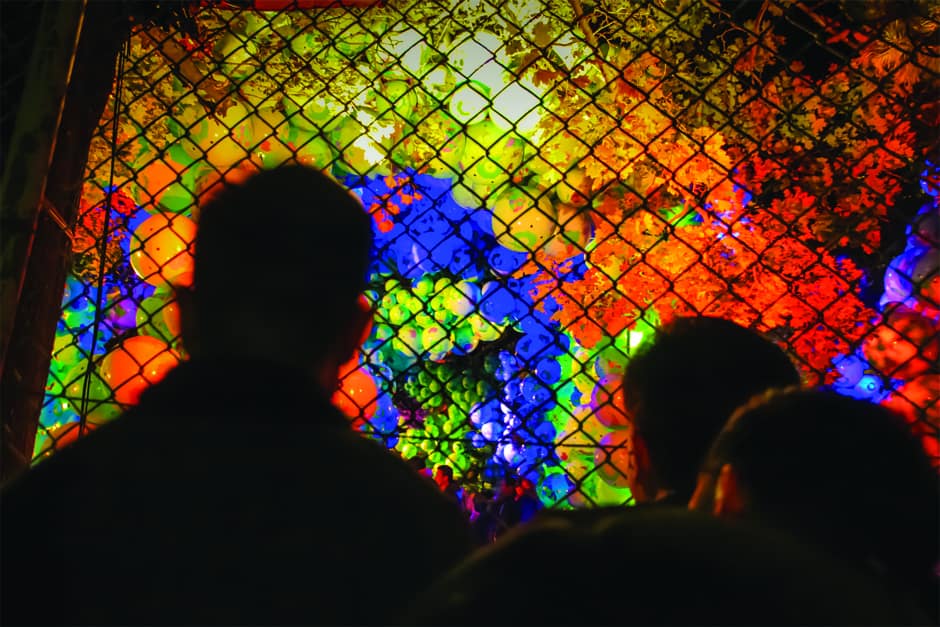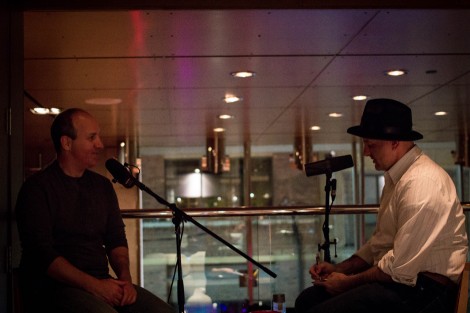If there’s ever a night to indulge your artistic curiosity, it’s Nuit Blanche. It’s an evening that never seems to go quite as planned, but sometimes that can be for the best — you see parts of the city you wouldn’t normally enter, stumble across exhibits you didn’t intend to see, and engage with your curiosity in a way you wouldn’t usually do. With all this in mind, here is a record of our evening, featuring the art that we did (and did not) plan on seeing.
Wanwu: Metamorphosis, 2014
This was one of the projects I was most looking forward to seeing. Taking place on the green-lit rooftop of City Hall, a “canvas” was laid out, and what smelled like Chinese ink was spilled all over it. In an hourly performance titled Metamorphosis, a flute player came out with a dancing performer wearing an unsettling mask. The performer then used interpretive dance to create a painting through his movement in the ink. The idea was that as this was happening, water would rain down and simultaneously destroy the art as it was being created. Unfortunately, while the mixing of different mediums was interesting, the people who sprinkled water onto the canvas looked like volunteers and failed to create the illusion of “water falling onto the paper in a steady stream like rain” (as described on Nuit Blanche’s website). Even though all I heard around me during the performance was “This is so weird” or “I don’t get it,” everyone made a point of clapping enthusiastically at the end.
— A.P.
Split Chorale for Viljo Revell, 2014
Visiting this project felt more like an experience than a viewing of performance art. Inside City Hall, the artists created a type of inverted theatre. A projection of video montages was reflected on the central stalk in the building, showing a male chorus singing in a continuous drone. At the same time, a legion of “real” choral singers wearing tuxedos were watching the audience from the wrap-around balcony over the first floor. The projections would occasionally silence, and the present choral singers would begin to sing. Confusing yet enticing, it was fun to walk around the stalk and see the different projections in which some of the chorus members deviated strangely from their singing (like the one guy who took his pants off, and another who peeled and ate a banana). The exhibit was pretty much exactly what it had said it would be and was one of the best-organized exhibits I saw at Nuit Blanche.
— Aneta Perehinets
Sex Worker, Truth & Archetype
I made my way down to Queen and McCaul to see Sex Workers Truth and Archetype, created by Esther Buckareff, Barbara Greczny, and Michelle Breslin. Meant to challenge “the public to redefine who or what is a sex worker,” the exhibit was made up of stylized photographs of nine different sex workers expressing how they view themselves. Each photograph was accompanied by interviews with the participants on a range of topics, including feminism, sexuality, law, family, and work. They were wonderful — my favourite was “Outlaw” and depicted “Fiona,” face covered, holding a gun, and kneeling next to a dog in the woods. Documentary videos accompanied the portraits, and in my mind they were the best part of the entire exhibit. Each story is candid, allowing the viewer unprecedented access into the lives and thoughts of the participants. I could have listened to the interviews for hours and would definitely visit again: the exhibition runs at the Beaver Hall Gallery until October 23.
— Erin Tobin
Global Rainbow
Yvette Mattern’s impressive light installation, Global Rainbow, blazed across Toronto’s night sky, visible to anyone visiting the southwest of the city. At first glance, however, the rainbow seemed but another light among many in a large city like Toronto. Indeed, all the seven colours merged into one while the crowded streets and myriads of city lights distracted the viewer from the piece. Yet, when I managed to place myself in a darker corner of Chinatown, the rainbow took on a completely different appearance. Each of the seven colourful strips of light appeared to be an individual artistic display — beautiful, unique, and personal. After sharing this intimate moment with the artwork, I no longer lost the rainbow in the colourful collision of lights. It is striking how an art piece of such scale can have a greater impact in a more intimate setting.
— Lola Borrisenko
Supporting the Arts, Another Project By Tough Guy Mountain
I found my way to the Whippersnapper Gallery, where we stood outside of a tiny glass box in which the performers were encased. In the box, painters created art on canvasses and each other, while corporate executives looked on from an elevated platform, spewing manifestos about art contracts. The only hitch was the crackling microphones through which the corporate executives spoke, making it nearly impossible to hear them.
— E.S.
The Insomnia Project
The Insomnia Project consisted of spectators sitting in the hotel lounge of Hotel Le Germain Toronto, watching a projected display of images while a fedora-wearing interviewer held a conversation with someone above the lounge. The conversation was apparently digitally screened to insomniacs across the world and, while it was calming to listen to the interviewer’s voice and there was a certain novelty to peeking into the interviewee’s life, the performance was boring overall. The chairs were too comfy to stay awake in during Toronto’s largest and most universal insomniac night.
— Emily Scherzinger
Between Doors
Between Doors dealt with the age-old question: do we have the freedom of choice? I was presented with a set of doorways — then another, then another, and so forth — and encouraged to walk through the installation based on automatic decisions. However, I found the artists undermined the complexity of their subject by moving into cliche territory: the doors within a given set had contrasting terms or phrases written on them — “in love” / “never in love” and “I can’t change” / “nothing changes” are a few examples. The installation became a teen magazine quiz instead of a meditation on freedom and will.
— Ivana Dizdar
Texting Syria
Around midnight, the crowds around Queen Street started to worsen, and it was pretty much impossible to see any art, so I headed past the hordes to Queen Street & Strachan Avenue, near Trinity Bellwoods Park. Just inside the park was Texting Syria, an exhibit by Liam Maloney. Inside a shipping container, photographs are displayed of Syrian refugees texting their missing families. Before entering the exhibit, you are asked to text a phone number, and then while looking at the portraits, text messages between the refugees and their families appear on your phone. It’s eerie reading messages like “It’s ok. We’re under siege but they are able to bring in bread” from your own phone. The photographs themselves were compelling, but the entire collection along with the messages can be seen online. I left a little disappointed, because while it was an interesting premise, it wasn’t worth the 40-minute trek.
— E. T.
Gap Ecology (Still Lives with Cherry Pickers and Palms)
Gap Ecology, though a massive installation, took a second to notice (or at least to recognize as art). Several boom lifts were parked off of Queen Street — they fit in with the road-closure signs that were up all over the place, and let’s be honest: in Toronto, crane-like mechanisms are no less common than lampposts. But upon looking up, it became obvious that the tops were filled with palm trees. The image of uprooted trees is always unsettling, and even more so amid the concrete hub we call our city. — I.D.



